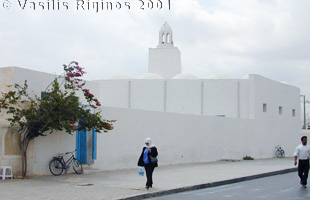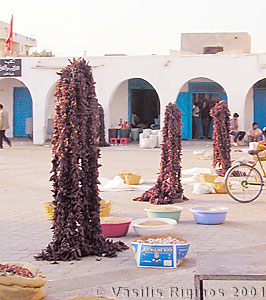This web page contains the logs of the fifth leg of a trip that I took with S/Y Thetis from Greece to Tunisia and back. The page covers a 7-day period of land exploration in South Tunisia using the marina of Monastir as our point of departure. Places visited are: Monastir, Sousse, El Jem, Jerba, Tataouine, Matmata, Douz, and Kairouan.
The logs are illustrated with maps and photographs, and also includes some historical and geographical descriptions of the places visited as well as several links to other related web sites.
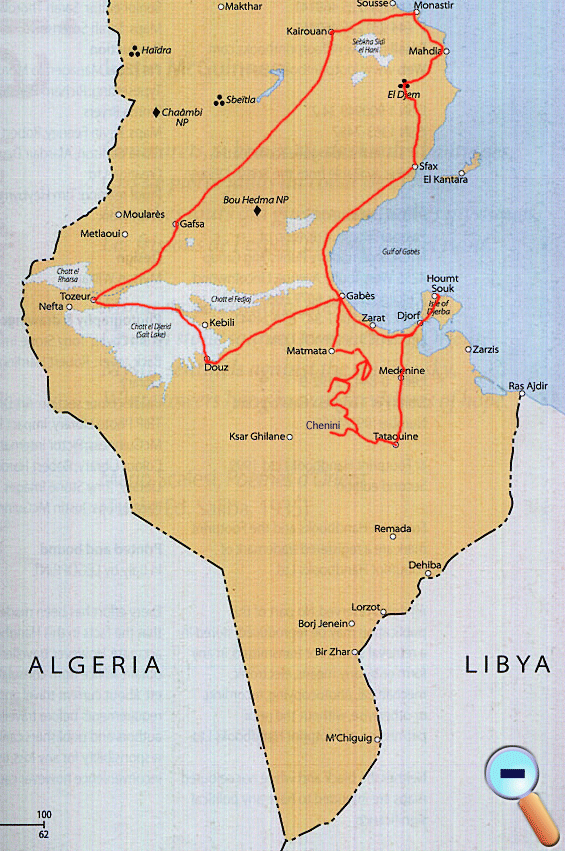
Tuesday May 22 2001, Day 19
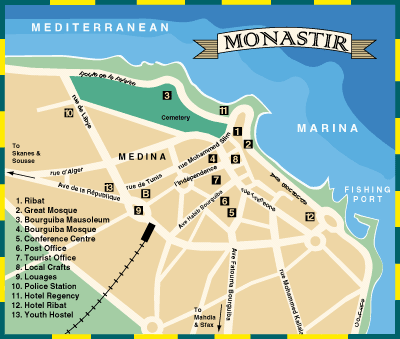 We were a little disoriented about where things were in the marina. According to the North Africa Cruising Guide there are showers, laundry facilities, etc. The shower/WC was not only quite far away from where Thetis was docked but it was locked. We tried last night to see how we could gain access to it but the “marina office” was closed. This morning I set out to explore our immediate environment. First I located the laundry. It was closed but a sign informed me that it opens at 9:00 AM. I then went to the Customs and paid the 1 TD (Tunisian Dinar) and they placed a stamp (χαρτόσημο — a bureaucracy stamp that looks like a postage stamp) to our cruising permit, so now it is valid. They told me that to obtain a key to the “sanitaires” (showers and WC), I need to go to the Capitanerie (Harbor master), pay a deposit of 1 TD, and they will give me a key to the facilities. I got to the Capitanerie (marina office actually) but the man in charge of keys was not there. Eventually, they took my deposit and gave me the cleaning lady’s key. The “sanitaires” were nothing but sanitary. The floor was wet, the room was dark, and the toilet not only had no seat but was foul smelling. To top it all, it was a long distance from Thetis. However, I found a WC that was cleaner and open at the shopping complex near our dock where both the laundry and the currency exchange were located. I also located, just outside this shopping complex, a “Supermarche” (supermarket) where I got some fresh bread.
We were a little disoriented about where things were in the marina. According to the North Africa Cruising Guide there are showers, laundry facilities, etc. The shower/WC was not only quite far away from where Thetis was docked but it was locked. We tried last night to see how we could gain access to it but the “marina office” was closed. This morning I set out to explore our immediate environment. First I located the laundry. It was closed but a sign informed me that it opens at 9:00 AM. I then went to the Customs and paid the 1 TD (Tunisian Dinar) and they placed a stamp (χαρτόσημο — a bureaucracy stamp that looks like a postage stamp) to our cruising permit, so now it is valid. They told me that to obtain a key to the “sanitaires” (showers and WC), I need to go to the Capitanerie (Harbor master), pay a deposit of 1 TD, and they will give me a key to the facilities. I got to the Capitanerie (marina office actually) but the man in charge of keys was not there. Eventually, they took my deposit and gave me the cleaning lady’s key. The “sanitaires” were nothing but sanitary. The floor was wet, the room was dark, and the toilet not only had no seat but was foul smelling. To top it all, it was a long distance from Thetis. However, I found a WC that was cleaner and open at the shopping complex near our dock where both the laundry and the currency exchange were located. I also located, just outside this shopping complex, a “Supermarche” (supermarket) where I got some fresh bread.
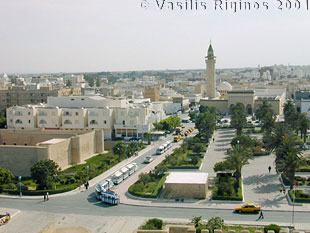
We took three loads of laundry for washing. It will cost us 12.5 TD (~ $9) and it will be ready tomorrow in the late morning. Having finished with all boat and housekeeping errands, we walked to the town and the Medina (walled city). As the guide book warned us, the buildings are fairly new and nondescript but the town is nevertheless an attractive bustling place. There are many stores catering to tourists, selling very attractive pottery, glass, leather, and other goods. The place does remind me superficially of Turkey. This impression is re-enforced by the hustling shop proprietors who relentlessly insist that you enter their store. I find this extremely annoying and it prevents me from window shopping or actually entering a store.
Monastir, like many harbors in Tunisia, was founded by the Phoenicians who called it Rous. After the Romans defeated the Carthaginians (Phoenician colonists) they renamed it Ruspina. The Byzantines fortified it, in the late 7th century, and finally the Arabs built the Ribat in the 8th century. The Arabs used this as a base to harass the Christians in the North and defend themselves from the hostile Berbers of the interior. Habib Bourguiba, the father of modern Tunisia, was born here. His massive mausoleum dominates the town.
After some long wandering, we ended at the Medina Pizza restaurant where we had a tasty sea-food pizza and salads but a beer could not be had. We wandered some more. We sought the gardens near the bus terminal that Alice had seen in the guide book. They seem to house some animals but we could not get very far because they were under construction. I noticed on our walk that there were very few food stores.
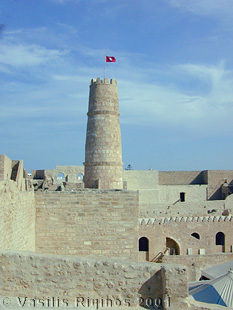
The Ribat at Monastir |
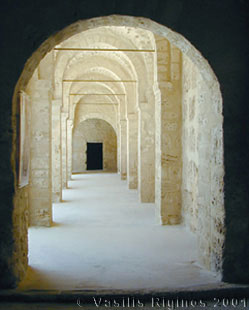
Inside the Ribat |
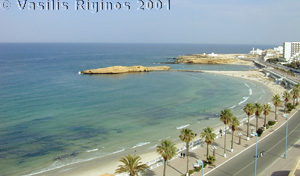
We went back to Thetis and rested for a while. The day was warmer than yesterday: 28°C, 77% relative humidity. The barometer had risen dramatically since yesterday from 1007 mB to 1015. After some rest, we set out again. This time we went to the Ribat of Harthena, the castle that dominates the waterfront. It is an amazing structure, almost out of an Arabian Nights picture book. Inside there is a nice little museum. We wandered around the tower and ramparts and the courtyards. Here one can imagine the Barbary Pirates celebrating their most recent captures. After the Ribat, we walked to the nearby Museum of Folk Arts and Traditions. It houses a large exhibit of very elaborate wedding dresses. They do look very hot, weddings must had been fairly uncomfortable, at least for the brides.
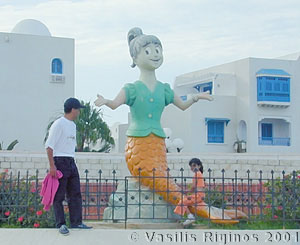
In the evening we had a very good dinner at the Hanibal restaurant. We gorged ourselves on seafood for 60 TD (~$43). Over dinner we discussed what our next move will be. We could rent a car and sight-see the nearby area or we could sail south for a few days before turning north to Tunis. On the other hand, we could leave Thetis here at the well-protected secure marina for several days and drive a rented car south before sailing north. Tunisia is actually larger than it appears from the tourist guides.
Wednesday May 23 2001, Day 20
The day had a fairly slow start. I turned on the watermaker, just to keep its membrane clean, but it did not produce any fresh water. I troubleshot the plumbing and the solenoid but all were OK. It must be that its membrane, despite all my efforts, was still fouled. I will have to soak it with both acid and alkaline solutions.
We went to the Capitanerie. A very nice French lady who spoke excellent English helped us to make plans for extensive sight seeing. We had already decided not to sail south of Monastir and to abandon Thetis here at the marina while we explored points south by land. The nice lady suggested two alternatives: rent a car for a week or join a “safari tour.” The later will take three days, beginning on Saturday, and covers over 1,000 km.
While digesting these options we walked through the Medina to the bus station looking for a bus to Sousse, an interesting town N of Monastir. We did not find the bus but we did find instead a louage (a station wagon that fills up with passengers and goes to a predetermined destination, similar to the Turkish dolmous). We climbed in, paid the 2 TD fare and soon we were on our way. It left us at some forlorn part of Sousse and not where we were led to believe from our tourist guides. We were totally disoriented. After wandering in terra incognita we took a taxi for 3 TD to the Sousse Medina.
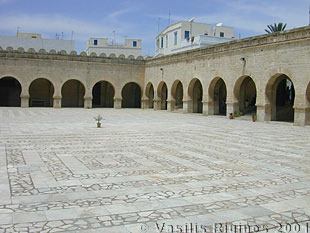
Sousse was one of the three Phoenician “great cities.” It did not participate in the Third Punic War and thus unlike Carthage avoided destruction by the Romans. It became a Roman city known as Hadrumentum. In the 3rd century AD the emperor Diocletian named Hadrumentum the capital of the province Byzacena (southern Tunisia). The Byzantines called the city Justinianopolis after the emperor Justinian who fortified it. In the late 7th century the city fell to the Arabs who built the present city over the Byzantine fort. It was from here that in the 9th century the Arabs embarked for the conquest of Sicily. After the French invaded the region in 1881 Sousse became the dominant city in the region. The present president of Tunisia, Ben Ali, comes from Sousse.
We saw the famous Grand Mosque. It is very impressive, with a large and lovely courtyard, beautifully engraved doors, and it is immaculately clean. The only problem was that we could not enter the interior—no non-Moslems allowed (unlike Turkey). The friendly guard engaged Alice in a long conversation on what to see here in Sousse.
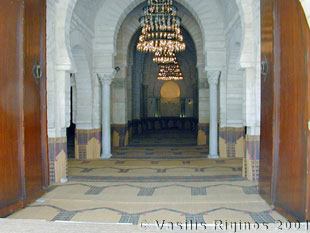
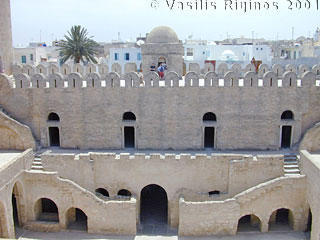
After a cold drink, along with some wonderful bread that we had bought in the Medina in Monastir, we visited the Sousse Ribat. It is smaller and newer than the one in Monastir but it is still a very exiting and enchanting place. Again, we spent some time on the roofs, terraces, and ramparts, and the tower. Climbing one Ribat tower every day should keep us in wonderful physical shape!
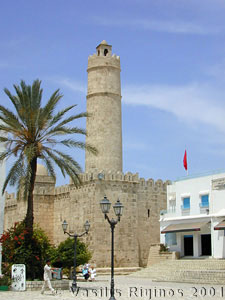
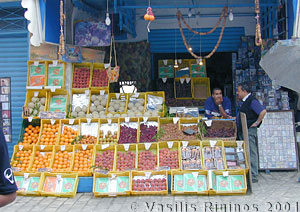
After we finished with the Ribat we walked through the medina toward the Archaeological Museum. The medina here in Sousse is much older and more elaborate than the one in Monastir. There were many small live turtles for sale. We could not figure what the people who buy them do with them. By the time we reached the museum it was 1330 and it was closed. We were not sure whether the summer or the winter hours were in effect. According to the tourist guide and assuming summer hours, it should either open at 1400 or else in 1500. This was also confirmed by a rather defaced sign at the door. We waited under a shady pepper tree eating some more of our bread and drinking water from a bottle that we had previously purchased. It would had been a pleasant break from our sightseeing but for the nasty exhaust fumes from the heavy traffic.
1500 came but the door did not open. Two young women also came and were looking at the sign with us. As they were leaving, I asked them when will the museum open.
— It will it open at three
— but it is 10 minutes past three
— no, it is 10 minutes past two.
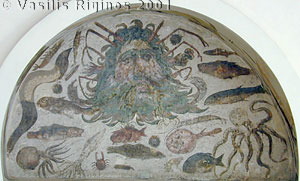
Sousse Museum
It turned out that we were on “European” time and not on “Tunisian” time. “Tunisian” time is, like most of Europe UTC+1 but unlike Europe it does not advance in the summer to daylight saving time UTC+2. So, we have been in Tunisia 1 hour out of step for the past 2 days. At 3 PM on the dot, Tunisian time, the museum did open. Our long wait was rewarded by a truly remarkable and extensive collection of late Roman and early Christian mosaics. Wonderful, whimsical designs and colors. Neptunes, nymphs, fishermen, gods, goddesses, animals, you name it. Room after room. I have never seen so many mosaics.
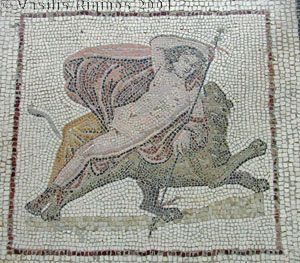
|
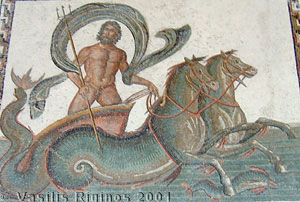
Neptune Mosaic |
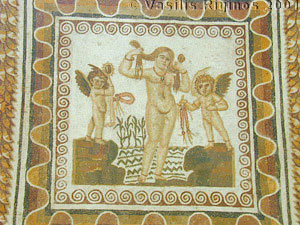
Venus |
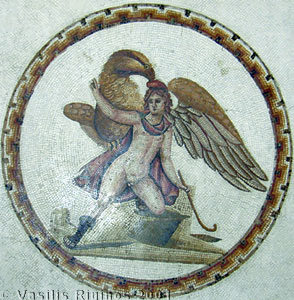
The Rape of Ganymede |
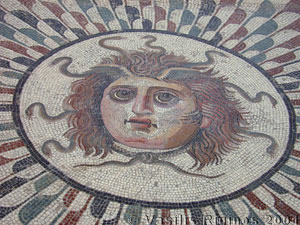
Sousse Museum
After the museum, we walked through the medina again to where our tourist guide indicated was the louage parking for Monastir. No louage in sight. Our book, 2001 edition, was out of date! Fortunately the train station was near by, and it had not moved. We bought 2 tickets for Monastir and waited for the train. It was crowded with mostly school children. We sat down among them, but the two who were sitting next to us got up and moved away, preferring to stand rather then sit near the two “foreigners.” No one from the crowded car sat next to us. By the time we got back to Monastir, it was getting late and chilly. We walked to our floating home.
Alice made a potato salad which we ate in the cockpit along with some Tunisian wine. It started to drizzle. All together a long but very interesting and satisfying day in a new and exotic land. We really are in an African Arab country!
Thursday May 24 - Friday 25 2001, Days 21 - 22
I am writing this from the hotel Lotus in Jerba. Jerba is believed to be the land of the “lotus eaters” of the Odyssey. Yesterday morning we arranged at the Capitanerie to rent a small car for 5 days. The price was 350 TD (~$250) but it had to be paid in cash and in advance. I was told that the car will be at the Capitanerie within half an hour. Since I did not have all this cash on me I rushed to town and fed my bank card to an ATM. The largest amount the machine would disperse was only 100 TD, so I had to do the ritual 4 times. On my 4th attempt, the machine refused my card. I had to find another ATM and try again. Then, I ran back to the marina and the Capitanerie just in time to take possession of a cute Renault Clio.
Back on board Thetis we started packing for the land trip and preparing the boat for her unattended stay at the marina. By early afternoon we were on the road towards El Jem.
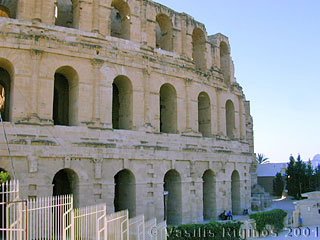
We stopped on our way to the Lampta Museum but it was closed until 4 PM and we were forced to skip it because we did not want to wait for 2 hrs. We kept driving. The El Jem Roman amphitheater was nothing short of amazing in its sheer size and state of preservation. It looks more like a movie set than a ruin. As a matter of fact, a crew was setting up for shooting a movie on Philip of Macedon.
El Jem in the 5th century BC was known as Thysdrus, the center of the seven agricultural provinces of Carthage. In 146 BC it was colonized by the Romans. By the 3rd century AD it had 30,000 inhabitants and many villas belonging to wealthy landlords. It was then that the amphitheater, the third largest in the Roman Empire, was built.
While walking to the amphitheater a little man approached and hearing us speaking Greek and offered us an early modern Greek coin for sale for only 30 TD. At first I declined but he found me again and after I offered him 5 we settled for 10 TD. I hope it is not a fake.
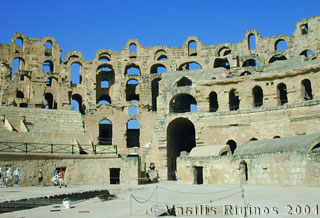
Inside |
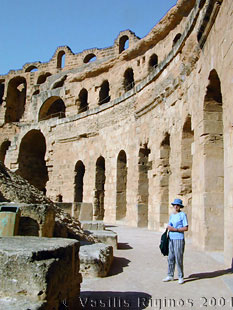
Alice |
After our visit to the amphitheater, we walked a considerable distance to the museum. It is very nice and full of late Roman mosaics.
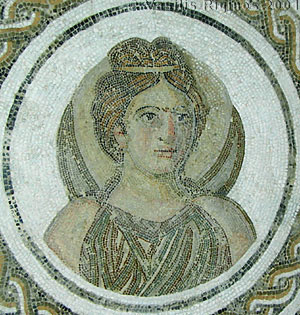
Portrait of a Roman Lady |
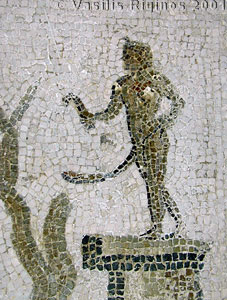
|
By the time we finished with the museum it was getting late. We decided to stay at El Jem in the hotel Julius which was recommended by several of our tourist guides. We ate at the restaurant. It is a “licensed” restaurant which means that it is allowed to serve alcoholic beverages such as wine and beer (there are not many such restaurants in Tunisia). It was full of men smoking drinking and watching television. Alice was the only woman. The food was indifferent. The room was all right, BUT the toilet stank—no water trap. Also, the bed sheets were threadbare and uncomfortable. It was a miserable night. Needless to say we got up rather early. Before leaving El Jem we strolled in the already bustling (mostly men) town. We bought some fruit, spring water, and fresh bread. In the grocery store we noticed that they were selling dry chick peas, already soaked in water.
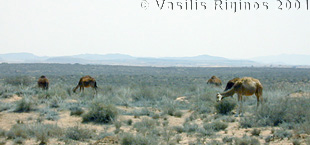
After paying the hotel bill of 25 TD we hit the road towards the island of Jerba in the south. We drove through endless olive groves, littered by amazing quantities of plastic refuse. At Sfax we hit our first Tunisian traffic jam. We were engulfed in thick Diesel fumes from myriads of lorries. We crawled at a snail’s pace but eventually we emerged out of the city. Past Gebés the landscape changed from olive groves to desert. We even saw a herd of camels.
Taking the ferry from the mainland to the island of Jerba was much easier than we expected: no wait and the cost, 2 people plus car, a mere 800 millens (1000 millens = 1 TD). Jerba itself proved to be somewhat of a disappointment. I was expecting, from the guide books, stunning architecture but most of the buildings were just the standard issue concrete box. We were looking for a hotel along the SE beach that had a glowing description in our guide. Instead we found one huge hotel complex after another. None of them looked very Tunisian nor attractive. We ended up driving west to the main town of Humt Souk and registering in the oldest but attractive hotel the Lotus. The room was old but with high ceilings and most important of all with a toilet that did not smell.
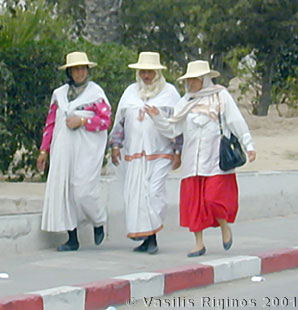
In Jerba there is a Jewish community of about 1,000 people. They claim that their ancestors arrived here from Jerusalem in the 6th century BC and it is one of the earliest Jewish settlements in the world. The El Griba Synagogue was built in the 1920s on the site first chosen in 600 BC when a holy stone fell from heaven and a mysterious girl appeared to direct the building of the original Synagogue. It is believed that when the last Jew leaves Jerba, he must lock the Synagogue and throw its key back to heaven.
After a rest we walked in the large and attractive souk (market place). There were plenty of nice pottery for sale in colors, sizes, and shapes of every description. Unfortunately the hassling style of their vendors drove us away from buying any.
In the evening we ate a tasty cous-cous (the Tunisian national dish) dinner at the Restaurant Les Palmiers.
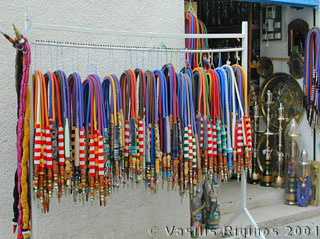
Saturday May 26 2001, Day 23
We slept well, a nice breeze came from the sea. We drove to the beach. It was lovely with large sand dunes and surf. The quantity of plastic refuse however was a big distraction to the natural beauty.
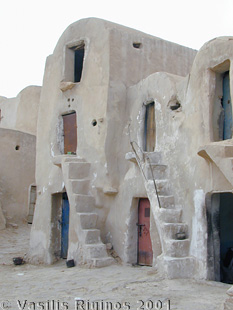
We took the ferry and drove towards Tataouine. On the way, we stopped at Medenine. Medenine used to be an architectural wonder. It had a series of ksour (mud buildings) some up to six stories high. Alas in the 1960s a misguided effort of modernization brought the ever voracious bulldozers which destroyed the ksour save but a few. We looked for these but there were no signs. We asked a policeman and he gave us some vague instructions in French (almost everyone in Tunisia speaks some French). After several false starts we did find it. It is photogenic but in a terrible state of deterioration. Hordes of horrid youths hounded us to buy cheap Egyptian scarab jewelry.
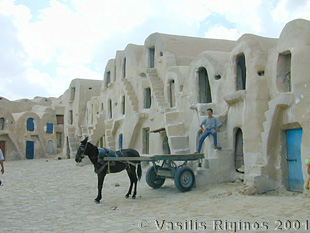
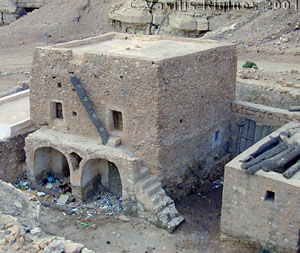
We continued driving. We went past Tataouine but did not stop, instead we drove to Chenini a village built on the mountain with many troglodyte houses in caves with a built facade. Again we were accosted by youths. Except for the youths, it is an impressive scenery but the troglodyte dwellings are in a sad state of disrepair. There are still quite amazing in their sheer magnitude covering the whole hill. Some of these dwellings are rather large. Again a lot of refuse scattered everywhere.
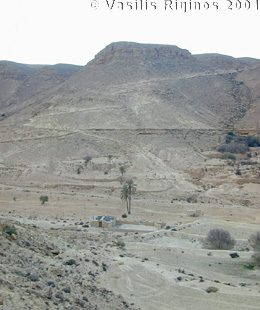
View from Chenini |
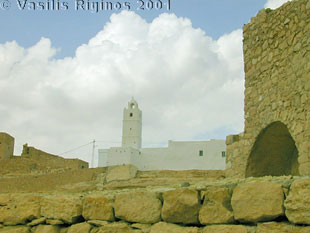
Chenini Mosque |
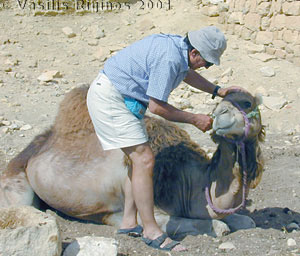
We decided to stay in a hotel at the outskirts of Tataouine. We found the Mabrouk, a brand new hotel with very attractive architecture. The room was very clean and cool and the hotel manager very attentive. After checking-in and a cool drink we drove to town to look at the two ksar (mud villages) mentioned in our guide book. No signs, no one seems to know about them, we got lost and we did not find them. We did find, with plenty of difficulty, the souk (market place). It is picturesque and non-touristic. Alice found the carpet store recommended by the guidebook. The young proprietor was very friendly and spoke good French and his young brother-in-law-to-be, an Arabic teacher, spoke reasonable English. We ended buying a kilim carpet.
We ate at the hotel as we could not refuse its polite manager. We were the only customers in the large dinning room. The lone waiter showed us to a table under the ever present TV. We indicated that we would prefer another, as far away from the TV and near a window. We moved and then we realized the waiter’s reluctance. Right there next to the window were his street clothes and underclothes. The food was not bad but hardly remarkable. When we paid our bill the waiter with great embarrassment searched the pockets of his street pants, hanging by the window, for change. The fresh cold desert air was wonderful. We did sleep well.
Sunday May 27 - Monday 28 2001, Days 24 - 25
 We are back on Thetis, our land adventure is over. These past two days were full of marvelous sites, frustrations, surprises, and disappointments.
We are back on Thetis, our land adventure is over. These past two days were full of marvelous sites, frustrations, surprises, and disappointments.
Yesterday started rather well. We left the Mabrouk hotel, fairly early in the morning, and after looking at the map we followed a mountain road, marked as paved, to Matmata. I wanted to visit Matmata, the scene where some Star Wars movie scenes were shot, because of its underground troglodyte houses. On the way, we stopped at the Berber villages of Guermessa, Ghomrassen, Ksar Hadada, and Beni Kheddache. Up to that point the road was good and the scenery over the mountains was breathtaking while the villages themselves were rather nondescript.
At Beni Kheddache there were several roads going vaguely in a northerly direction but none of them was marked. We tried to ask for directions to either Matmata or Teshine, a village about half way to Matmata. We either got conflicting directions or blank stares. We followed one of the indicated directions (at least two people pointed to it) and we ended in a small ksar (village). Same story: no signs and conflicting directions. We followed a road leading west and we even saw a road sign: “Matmata 48 km” but it pointed to a dirt road and our map showed a paved one. We continued on the asphalt road but after a few kilometers it ended. Back to the sign, we took the dirt road. After driving 7 km there was another sign: “Matmata 35 km” with an arrow. We followed the arrow for about 10 km going past a very small village after which the road deteriorate completely. We asked a youth and he told us, in recognizable French, that we should go back. We had gone the wrong direction of the arrow.
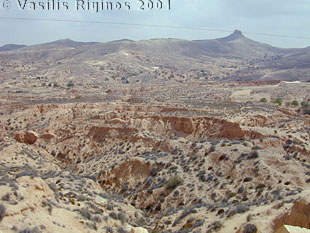 We backtracked and followed the second fork. We drove for another 15 km past the sign. The road deteriorated and led us over several mountains. The scenery was terrific but we were afraid of getting stuck. A small truck came on the opposite direction. This was the only traffic we had seen since we entered the dirt roads. The farmer driving the truck told us that the road further down gets even worse and it would be impassable by our little car. He advised us to turn back and follow him. This we did for a long distance. He then pointed us at another, unmarked, dirt road which he promised will lead us to Matmata.
We backtracked and followed the second fork. We drove for another 15 km past the sign. The road deteriorated and led us over several mountains. The scenery was terrific but we were afraid of getting stuck. A small truck came on the opposite direction. This was the only traffic we had seen since we entered the dirt roads. The farmer driving the truck told us that the road further down gets even worse and it would be impassable by our little car. He advised us to turn back and follow him. This we did for a long distance. He then pointed us at another, unmarked, dirt road which he promised will lead us to Matmata.
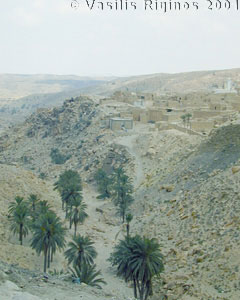
We went past Ksar el Halouf and the road improved from dirt to partly paved. On we went until many kilometers later we reached Toujane, a very picturesque ksar with troglodyte houses. Like every other ksar we went through, it too was full of garbage but its setting over the cliffs is magnificent. Just outside the ksar the road forked, a sign indicated two names none of which we could locate in our road map. According to our travel guides one of the roads leads to Matmata, after 28 km, but which one? We backtracked and asked a group of youths. One of them entered the car to “show” us. We followed his instructions. At the fork, he got off and asked for a tip. On we went past several small ksar, not shown in our map, when we reached a sign “Matmata 40 km.” It seems that after all these hours of driving we had not gotten any closer to our elusive goal.
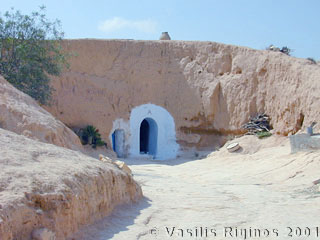
We followed the road, now paved, and we reached Matmata Nouvelle (New Matmata). All of our guides gave only the briefest mention of this village, and none mentioned that it was more than 20 km from old Matmata. One of the guides suggested that we hire a local kid to show us the underground troglodyte houses. We got one that seemed less aggressive and on we went. He indeed took us to a rather interesting house. These houses are built underground by excavating a shaft in the soft earth. They all have a large hole which creates a courtyard below ground level with rooms excavated all around it. A tunnel entrance from outside leads to this courtyard. After seeing the house, we gave some dinars to the proprietor, but our kid-guide refused to get back into the car and demanded a 20 TD tip. I gave him 10 but felt cheated. We drove into Matmata proper and walked around. On our way out we visited another troglodyte house, less impressive than the first, but not very different.
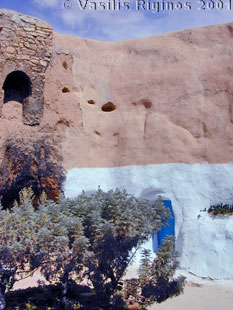
The Courtyard |
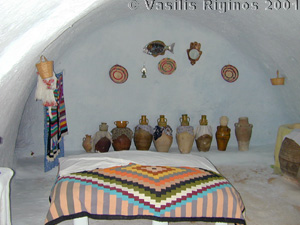
The Bedroom |
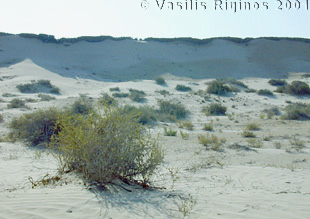
By then it was past 3 PM, too early to seek night accommodations but too late for more sight seeing. We got back into the car and drove to Gabés from where we headed west to Douz via Kebil. Douz is a town within the Sahara Desert. As we were approaching it the scenery changed completely to sand dunes consisting of extraordinarily fine sand. Very impressive. By the time we reached Douz we were low in both gas and cash but we could not locate an ATM.
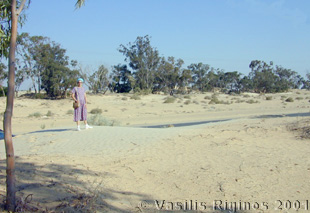
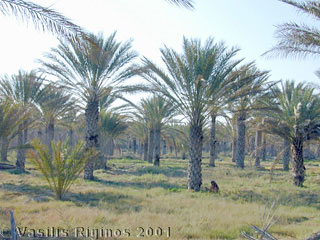
Douz is in the center of an oasis, a Palmery, a thick forest of over 400,000 palm trees. It is shaded and cool. Within the forest, but outside the town, there are a number of luxury hotels. We checked-in the Touareg a large but very pleasant and well established hotel. Many camel caravans were bringing back the tourists from their daily tours. It is possible here to get into a camel caravan that overnights in the desert. Unfortunately our time was running out and we could not do so. Maybe another time …
The hotel room was quiet, large, and comfortable. In the evening we went to the town and had diner at the Ali Baba restaurant that specializes in cous-cous. The proprietor, a large, bearded, dark skinned man, was very jolly and expansive. This was in contrast to our experience with Tunisian waiters up to now. They all seem to wear a very somber and sad expression. Our fare: brik, an egg appetizer, and lamb cous-cous which was delicious, the best I ever had. Too bad that the establishment is “unlicensed” and we could not have a beer or wine to go along with this wonderful food. I had a second portion of cous-cous as I was very hungry after such a long and tiring day.
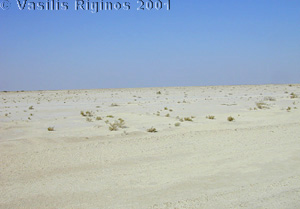
This morning, we left the hotel by 7 AM because we anticipated a long drive back to Monastir and Thetis. We have to return the car by tomorrow. As we were low on cash and fuel, we looked for an ATM but none were to be found in Douz and none of the banks had opened yet. We drove 100 km through the desert to the town of Tozeur. The drive was at first through the sand desert with, very sparse vegetation; this later gave way to the most desolate salt mud, a perfectly flat and lifeless landscape, the Chott El Jerid. It could had been in another planet. As we emerged from this no-man’s land we stopped at a café near the small town of Jelma. To our astonishment there was a sign for Nescafe in Greek! Tozeur seems a very pleasant town and we wished that we could had spent more time there. We just stopped long enough to get some cash from an ATM machine and then re-fill the tank of the car at a gas station.
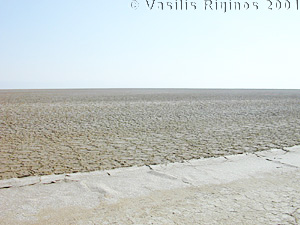
The Chott El Jerid |
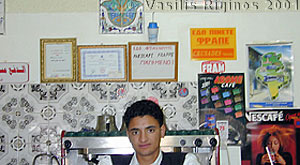
Greek in the middle of nowhere |
We continued our drive past the town of Gafsa to Kairouan the holiest city of Tunisia and the reputed 4th holiest city of the whole Moslem world. Here again we were confronted with a confusion of unmarked streets. Street signs are not too popular in Tunisia. We could not establish a correspondence between the city plan in our books and the reality confronting us. As we scrambled through the thick traffic to get our bearing, a teenage youth on a motor scooter came to our rescue. He told us in passable English that if we wanted to get to the Grand Mosque we should follow him. We turned to the right, then to the left, the right, and to the left again in a bewildering maze of narrow streets full of traffic. We were lost before but now we were hopelessly lost and totally dependent on the youth. We went past a city gate into the medina (market place) and he indicated to us to park at a conveniently empty spot, the only empty spot in sight.
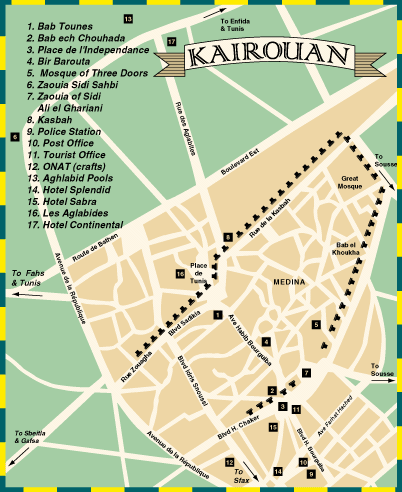
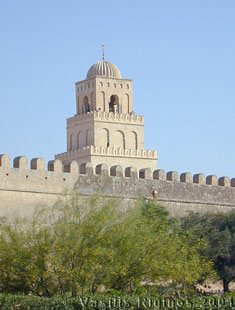
The Grand Mosque |
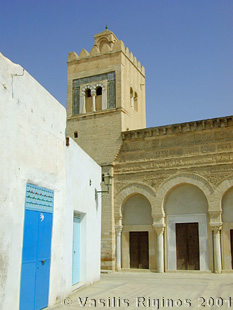
Another Mosque |
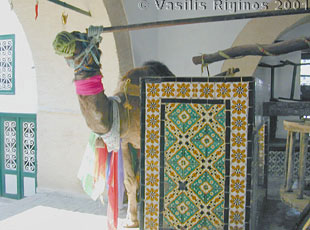
We got out of the car and were about to thank the youth when a bearded young man materialized and was introduced to us as the youth’s English teacher. While talking to the “teacher” the original youth disappeared. The “teacher” did indeed speak very good English. He said that he was a 4th year student of English literature at the university here and that he had traveled in both England and Greece. He welcomed the opportunity to show us around the “holy city” because he could not only practice his English but because he is deeply religious and he wanted, us the foreigners, to experience the traditional Moslem hospitality. He also wanted to reciprocate the selfless hospitality that he found everywhere he went in Greece. We wandered together around the medina talking about American literature, Islam, and Christianity while he pointed out Mosques, religious schools etc. Unfortunately they were all closed and we could not enter. He took us to the holy spring, the Bir Barouta, where holy water (costs 1 TD to drink) is pumped by a camel. It is believed that if you drink the water, which originates from Mecca, you will come back again to Kairouan.
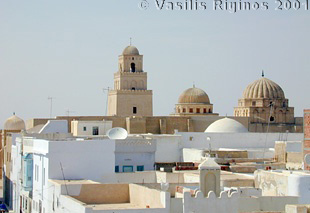 He then led us to a roof on top of a carpet store (this did make us suspicious about our devout student) where we could see a bird’s eye view of the medina and the Mosques. Then, despite our strong reluctance, he got us into the store so that “we can appreciate the splendors of the old weaving traditions of Kairouan”. Tea was offered and although we did make strong representations that we were not interested in buying any rugs, a great show of the shop’s wares was put on for our benefit. The English student/teacher conveniently excused himself, due to a “call of nature,” and disappeared. In his absence the proprietor put on a very sleek and persistent sales pitch which wore down Alice’s resolve. He did, I must admit, show us a very handsome rug at a reasonable price. Out came the Visa card and for a charge of 400 TD (~$285) it became our newest possession. It was wrapped in a neat package in no time. The proprietor threw in a tiny “camel” rug as a gift after he asked us to give a 20 TD tip to the “boys” (the 3 men who rolled and unrolled the rugs he showed us). We, armed with the package, walked out into the daylight and were about to enter the car, which by a pure coincidence was parked right in front of the carpet store, when our devout student-guide made his appearance, after communing with nature for the past 45 minutes. He congratulated us on our wise purchase and after saying how poor students are in today’s Tunisia he asked no less than another 20 TD for his labors. I gave him 10 but I felt as if I had just been raped. “Moslem Hospitality” my foot!
He then led us to a roof on top of a carpet store (this did make us suspicious about our devout student) where we could see a bird’s eye view of the medina and the Mosques. Then, despite our strong reluctance, he got us into the store so that “we can appreciate the splendors of the old weaving traditions of Kairouan”. Tea was offered and although we did make strong representations that we were not interested in buying any rugs, a great show of the shop’s wares was put on for our benefit. The English student/teacher conveniently excused himself, due to a “call of nature,” and disappeared. In his absence the proprietor put on a very sleek and persistent sales pitch which wore down Alice’s resolve. He did, I must admit, show us a very handsome rug at a reasonable price. Out came the Visa card and for a charge of 400 TD (~$285) it became our newest possession. It was wrapped in a neat package in no time. The proprietor threw in a tiny “camel” rug as a gift after he asked us to give a 20 TD tip to the “boys” (the 3 men who rolled and unrolled the rugs he showed us). We, armed with the package, walked out into the daylight and were about to enter the car, which by a pure coincidence was parked right in front of the carpet store, when our devout student-guide made his appearance, after communing with nature for the past 45 minutes. He congratulated us on our wise purchase and after saying how poor students are in today’s Tunisia he asked no less than another 20 TD for his labors. I gave him 10 but I felt as if I had just been raped. “Moslem Hospitality” my foot!
Leaving the holy town was not easy. While we were trying to get our bearing another youth on a motorbike appeared and offered to guide us. Not this time! Eventually, after some false starts we were out of town and followed a sign to “Sousse, Monastir, and Tunis.” According to our map, this local street led to two entrances: one nearby to the Sousse highway, and the other, about 9 km further, to the Tunis highway. We did come to the first entrance, nicely marked, but it was closed. We continued looking for the second. After driving over 10 km we still had not seen it. We asked a policeman in the next police block. These blocks are very common in Tunisia’s main roads. They consist of 3-4 policemen in different uniforms. They stop almost all the cars and look at their papers. Only if you are a foreigner in a rented car they wave you through. The policeman we asked indicated, in very hard to follow French, that we had to go back to Kairouan and try another road. Back we went into the maze. Several more of the youths on motorbikes hassled us. I was very agitated.
Finally, almost by serendipity, we found ourselves on the road to Sousse. But it did not last very long. Where was the exit for Monastir? After covering more than the distance indicated on the map for the exit, we still did not see it. There was, however, at about the right distance, another exit marked for a town not on our map. Several false turns later we did make it to Monastir and the marina. We were totally drained and exhausted. I have absolutely no desire to ever go back to the holy city of Kairouan and be hassled by motorbike riding youths or pious students under false pretexts. Returning Greek hospitality indeed! Nevertheless, our trip was overall wonderful and there are many places I want to re-visit. I particularly want to go back and spend some time in the desert regions of Douz and Tozeur.
All together we had traveled on land about 1,600 km.
